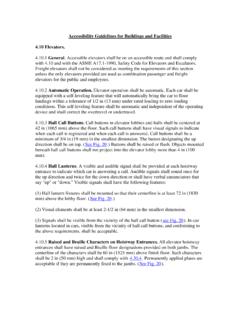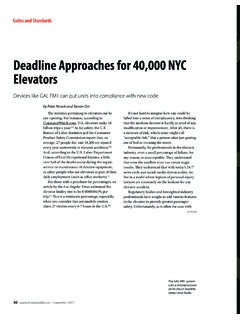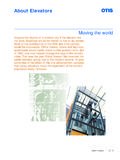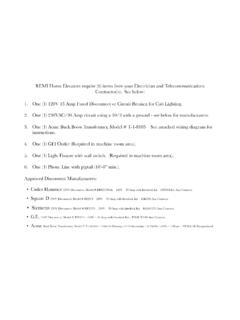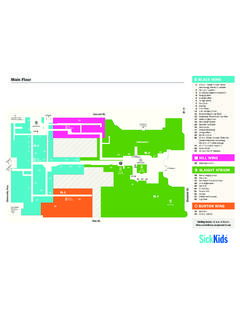Transcription of s T duc RO ELEVAT OR P - AFD Industries
1 elevator PROducTsPFEIFER DRAKODRAHTSEILWERK GMBH & CO. KGRHEINsTRAssE 19 23d-45478 MuELHEIM AN dER RuHRPHONE +49 (0)208-4 29 01-0 FAX +49 (0)208-4 29 01-21E-MAIL Wire Ropes in Elevators09/2015 Token fee 9,50 EuR2 PFEIFER DRAKOS teel Wire Ropes in ElevatorsPFEIFER dRAKO, an associate company of the PFEIFER Group, has produced and developed special wire ropes for the eleva-tor construction industry for almost 200 years. Thanks to the extensive sales & distribution network and numerous associate companies in all corners of the globe, dRAKO's special ropes are safely and reliably in use wherever people need to travel vertically. From Moscow to Kuala Lumpur, from New York to Hong Kong and also in Paris, London and Frankfurt, we build on close and long-term relations with our discerning customers.
2 In turn, elevator manufacturers the world over have come to trust us as reliable dRAKO, tradition and innovation share equal ranking: one aspect would not be possible without the other. To continue widening our knowledge about ropes and to ensure that our tech-nology remains truly state of the art, we collaborate with universi-ties and institutes. The streamlined precision manufacture of the serial products and the management of customized projects are governed by dIN EN IsO 9001 in accordance with our own quality management system (QMs).Our company handles resources with as little impact on the envi-ronment as possible. We are certified to IsO 14001 and work the highest safety standards economical levels of efficiency and reliable for the benefit of our customers, and that is our mission statement is defined as our adherence to the most up-to-date technical know-how, high-quality materials, safety, user-comfort and economic efficiency which are turned into a set of values transferred to our customers and enable us to embrace every challenge in a multi-cultural Production & Logistics site at Rheinstrasse, M lheim an der Ruhr, GermanyFront cover (left to right).
3 H tter-Aufz ge GmbH and Janzhoff-Aufz ge GmbH Eiffel Tower, Paris shanghai World Financial center, shanghai3 PFEIFER DRAKOS teel Wire Ropes in Elevators 09/2015 Contents Frequently asked questions about wire ropes in elevatorsWhy are wire ropes used in elevators? 4structure and components of steel ropes 4 Rope grade 5strand construction 7 Rope constructions 8 Which ropes are suitable for which installations? 10 Rope core 14 Lubrication 15direction of lay 16 Pre-forming 17 Pre-stretching 17 Rope diameter 17 Rope terminations 19 elevator ropes in operation 20storage of elevator ropes 20 Installation 21drive arrangement 22 Rope tension 23shortening of ropes 26spring deflection of the car under load 26 Relubrication 26discarding of
4 Wire ropes 28corrosion 30 Traction sheaves 31 Guidance for the selection of ropes 36 Our Service 38 Authors of the third revised version of this document published 2015:dr. Wolfgang scheunemann (Tcc) B. sc. Martin stroba (Produktmanagement) PFEIFER DRAKO M lheim RuhrAuthors of the second revised version of this document published 2011:Prof. dr. Wolfram Vogel (Tcc) Thomas schonlau (Product Management) Dr. Wolfgang Scheunemann (TCC) PFEIFER DRAKO / M lheim an der Ruhr, GermanyAuthors of the first revised version of this document published 2007 Thomas Barthel dr. Wolfgang scheunemann dr. Wolfram Vogel (all Tcc at PFEIFER dRAKO)Author of the original document: Michael Molkow / M lheim an der Ruhr, GermanyAdvantages of DRAKO steel wire rope Special wire ropes for your application Proven strand design and high adaptability Long service life DRAKO-made fiber core, constant quality Low elastic and permanent elongation Low maintenance costs 100 % rope quality, high quality assurance Fair cost-benefit ratio Highly qualified and experienced personnel Competent advice Reliable service Worldwide sales networkstate-of-the-art stranding technology in the production process4 PFEIFER DRAKOS teel Wire Ropes in Elevators 09/2015 Frequently asked questions about wire ropes in elevatorsWhy are wire ropes used in elevators?
5 Due to its design and a structure made up of many individual steel wires, steel wire rope offers advantages which clearly qualify it for use on elevators. Its benefits area) its redundancy andb) the capacity to identify the possibility of the end of service life or pre ferably the correct time for discarding the rope before its condition becomes dangerous by means of externally visible criteria such as. In what way are wire ropes exposed to stress when travelling over the traction sheave?When running over the traction sheave and the deflection sheaves, the wires in the ropes are exposed to a high complex of stress factors comprising tension, flexural stress, torsion and compression which all contribute to material fatigue. during flexural stress, the wires bend in relation to each other. The friction created between the wires results in additional abrasive wear.
6 Added to this is the influence of corrosive media. With increasing use, the abrasion characteristics become more pronounced, for example, the number of wire breaks over defined reference lengths increases. Regular inspection permits the correct time for changing the rope to be determined or the remaining service life to be is meant by redundancy?Redundancy actually means superfluity, a factor which is of extreme importance in the case of safety-relevant applications. A basic distinction is drawn here between active and passive redundancy. Active redundancy is provided by the interaction between wires laid jointly to create a rope or the multiple arrangements of suspension ropes in elevator systems. If one component fails, the remaining components take on its functions in line with their configuration.
7 Passive redundancy relates for example to safety gears which only move into action in the event of an uncontrolled travel and components of steel ropes Why do the wires in the strands and the strands in the rope have a helical structure?The helical structure (Fig. 1) addresses the fact that an elevator rope is bent over a sheave. This effect becomes evident if we imagine first a parallel wire bundle being bent over a sheave (Fig. 2). The inner wires lying on the sheave are too long and the outer wires too failure is the anticipated result. In a wire rope (Fig. 3), the areas with excess length and those with insufficient length lie one next to the other when running over a sheave, i. e. the strand only needs to shift marginally to achieve length compensation. For the individual wires in the strands, the same principle applies.
8 When running over the sheave, all components strand against strand and wire against wire are in continuous makes steel wire so special?The raw material for steel wire is unalloyed carbon steel with carbon content of or better to % by weight. Other materials such as silicon and manganese are only present in minimal quantities as regulated by EN 10016 [1].steel wires for elevators have nominal tensile strengths of 1370, 1570 and 1770 N/mm . Higher strength levels of up to 2500 N/mm are possible with special approval. A steel wire achieves these extremely high strength levels by a process of manufacture which combines forming with heat treatment. This entails passing rolled wire with a diameter of between 5 and 10 mm 5 RSH/HQJWK FRPSHQVDWLRQ6 WUDQG RU ZLUHP arallel wire bundleLength differencewhen bentInsidebentToo shortToo longDeflection sheaveOutsidebentOnly the central wire has the right lengthWire ropesStress factorsStructure of steel ropesFig.
9 2: Parallel wire bundle running over a sheaveFig. 1: Fibre core, strand, wireFig. 3: Rope running over a sheaveThe material5 PFEIFER DRAKOS teel Wire Ropes in Elevators 09/2015through nozzles (wire drawing dies) by repeated drawing when cold to gradually reduce the diameter. during this process, its tensile strength increases by a factor of 3 to 6. Before the first and between the drawing processes, the material is exposed to controlled heat treatment, which performs a process known as patenting. The relatively high tensile strength of the steel wires characterized by extreme microstructure banding is consequently not the result of factors such as a high content of alloying elements, but of material forming which has occurred when in a cold condition, Fig. 4 and damages the wire. It is said that the high-strength banded forced microstructure regains its original strength of around 400N/mm.
10 The period of exposure to heat by fire, friction heat, radiated heat, light arcs and heat from welding etc. also exerts an effect on the residual serviceability properties of the wire. At a temperature of 480 c, a complete microstruc-ture transformation takes place after 15 30 minutes. At higher tempera-tures, just seconds can be enough to cause permanent damage to thin wires of the kind used in products such as elevator is being given in various places to the possible use of alterna-tive wire materials made of stainless steel. However, ropes made of these materials have little to recommend them for use in traction elevators due to their inferior fatigue bending properties compared to ropes made of carbon steel wires. Moreover, they demand an extremely high is the significance of wire nominal tensile strength?
